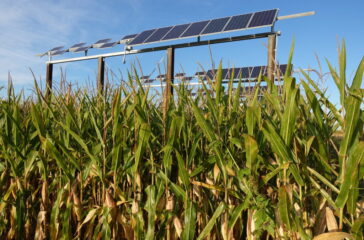Across the Midwest, farmers are turning to solar to boost profits
Grace van Deelen
In a corner of southwestern Wisconsin, in a town called Eden, Bob Bishop spends his days farming land that has been in his family since the 1940s. He manages about 2,000 acres— some is pasture for his cattle, some is seeded with corn and soybeans. But 40% of his acreage, as he likes to say, will soon be farming the sun.
Under a 25-year lease to a large solar project called the Badger Hollow Solar Farm, Bishop has agreed to the installation of solar panels across hundreds of acres of land he previously used to grow crops. The project, which is owned by energy companies Invenergy and Madison Gas & Electric, is projected to total 3,500 acres in all and generate enough energy to power more than 77,000 homes. The developers say landowners will collect an estimated $59 million from leasing their property to the project.
In agreeing to set aside some of his land for solar energy production, Bishop is one of an increasing number of farmers in the Midwest looking to solar as a way to add to – or replace – money made growing crops, and potentially help fight climate change at the same time.
The moves are triggering some controversy, as critics say filling large swaths of land with massive installations of solar panels is unsightly and inhibits needed food production.
But advocates say using farmland to harness a clean, renewable energy source is a critical move in the face of harmful climate impacts. The Office of Energy Efficiency and Renewable Energy (EERE), a part of the US Department of Energy, says that solar energy has an important role in cutting greenhouse gas emissions, improving air quality and reducing the strain on water resources that otherwise are tapped for traditional energy production.
Bishop said he considers the transition of his land to solar production as a welcome move. His land will produce far more usable energy per acre than it would if he was still growing corn for ethanol, Bishop said. And while growing corn requires regular management and costly inputs to control weeds and pests, solar panels require little maintenance.
“It’s all revenue,” said Bishop.
 EWG
EWG